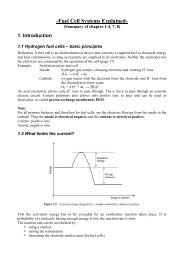Chapter 8. ORGANIC SOLAR CELLS - from and for SET students
Chapter 8. ORGANIC SOLAR CELLS - from and for SET students
Chapter 8. ORGANIC SOLAR CELLS - from and for SET students
Create successful ePaper yourself
Turn your PDF publications into a flip-book with our unique Google optimized e-Paper software.
2.2. C-SI TECHNOLOGY CHAPTER 2. C-SI TECHNOLOGY<br />
then R will increase. This is bad <strong>for</strong> the solar cells. How to compromise those two opposite effects is an artists<br />
work. The equation <strong>for</strong> the resistance is: . Another important aspect is the improve the aspect ration W/H.<br />
This leads to a decrease in losses as depicted in the diagram below: Furthermore grooves can be used in which<br />
the contacts are buried in the solar cells. Lastly the point contacts can be situated at the back of the solar cell.<br />
Preventing transmission of light rear surface<br />
We have already discussed about how to reduce reflection on the interface between semiconductor <strong>and</strong> air <strong>and</strong><br />
how to reduce front metal contact coverage. To increase the light absorption <strong>and</strong> increase e/h generation, we<br />
still need to reduce the transmission loss. The simplest method is to increase absorber thickness. Certainly, the<br />
thicker the absorber is, more light will be absorbed. According to measurement, 1mm thick c-Si will absorb all<br />
the light. Why we normally use 300 500micrometer thicker wafer. Of coursely, material will be saved. If we<br />
neglect cost issue, will the thicker wafer benefit the current or efficiency. Increasing the thickness of wafer is<br />
aiming to increase the path length which light travels inside the c-Si. but that is not the only solution, we can<br />
increase the path by manipulating the light traveling. One method is to use back reflection. If we back reflection<br />
is 100%, it is equivalent to double the thickness of wafer. When decreasing the thickness of the material it is<br />
necessary to use an appropriate light management within the solar cell. The absorption path length can be<br />
increased by scattering the texture at the front surface. The losses in charge collection can be summarized as<br />
followed:<br />
Loss in charge collection <strong>and</strong> separation<br />
1. Defects <strong>and</strong> impurities in silicon bulk can be overcome by improving the material quality. 2. Defecs <strong>and</strong><br />
impurities in silicon surface can be overcome by optimizing the surface condition 3. Defects in silicon-metal<br />
interface can be solved by reducing the area of metal contact<br />
Reduction of bulk defects<br />
In reality, crystalline structure can not be perfect. There always are some defects. There are three kinds of<br />
defects. Point defects: vacancy: some atoms are missing. Or some impurity will be inserted to the crystalline<br />
structure. Some small atoms are squeezed into space between atoms. Some large impurity could replace some<br />
atoms. Linear defect: a line of atoms are missing here. Planar defects: atomic arrangement is suddenly changed<br />
<strong>from</strong> different parts. All defects can serve a trap <strong>for</strong> recombination.<br />
Reduction of surface defects<br />
Only using high quality material is not enough. We still need to consider the surface of material because the<br />
surface has different properties <strong>from</strong> the inside bulk. At first, the surface contacts with environment, also during<br />
processes, inevitably, it is very easy to get some dirt on the surface. Secondly, every atom inside the bulk is<br />
surrounded by the same atom. But on the surface, atom at least on one side, there are no atoms , so the atom<br />
is not satisfied so there are a lot of dangling bond which is not conneted to other atoms. What we normally do<br />
is to grow a layer on both side of wafer. This layer will saturate those dangling bonds to prevent recombination.<br />
2. Conventionally SiO2 is thermally <strong>for</strong>med on very high temperature.this layer could also be SiNx sometime.<br />
Reduction of defects at metal-silicon interface<br />
In the area where the metal contact with semiconductor, electron also get lost easily since when two material<br />
contact to each other, they can never bond to each other perfectly. So we use this design, we make the contact<br />
area smaller , but make this part biger to keep low resistance.<br />
Enhanced e/h separation <strong>and</strong> hole collection at back contact<br />
This approach to reduce the e/h loss is not directly related to traps. The electrostatic field created by pn<br />
juntion is only hundreds of nanometer thick around the pn junction interface. But the wafer is about hundreds<br />
of micrometer thickness. So most of e/h do not feel that electrostatic field, they just move around r<strong>and</strong>omly.<br />
Some are lucky, they reach the pn junction interface <strong>and</strong> they get seperated <strong>and</strong> cellected. But some maybe<br />
move to the oppsite dirrection, they are just very stupid. E.g. electrons here. They are supposed to move<br />
upwards but some of them are move downwards. What will happen to those who are moving downwards. In<br />
bottom here there are full of holes. Electron wll recombine easily here. The solution is to put anther electrostatic<br />
field to seperate e/h pair, the field has a special name back surface field.<br />
13






